SECTION I
EXAMINATION OF INSTRUMENT HISTORIES
KAREL VANICEK
Investigation and documentation of all historical records concerning both operation of the Dobson spectrophotometer(s) and building up of the total ozone data base are the first steps that must be done before starting the re-calculation of the data series from any given station. An analyses of information collected in this way helps with decisions regarding how the sets of original input data should be created, what method is the most suitable for reprocessing the total ozone data, and which independent data sources can be used for verification and comparison of final results.
The Dobson instrument data series from each station is comprised of total ozone data sets obtained from measurements with one or more instruments. Therefore, examination of the station's historical files requires investigation of the historical records of all of the Dobson instruments and their data sets. This is the main reason why technical records and data files of individual instruments are taken in this Handbook as primary sources of information for re-evaluation of the whole data series or its individual parts.
This section recommends chief steps to be taken when examining a Dobson instrument's history and records. They can be briefly characterized as follows:
- collection and saving of all historical materials and information concerning the instrument and its operation that are essential for assessment of measurements and data re-evaluation
- making these records available in archival files prepared for final re-processing of the ozone data
- compiling a complete historical record for the entire data series of given station
1.1 History of the Instrument
Before starting re-processing of the total ozone data it is necessary to assemble as much information as possible about the history of the instrument in order to document all non-technical aspects of its function. This concerns mainly such important particulars like installation and maintenance of the spectrophotometer, periods of its operation, schedules of measurements, original system of data collection, processing and archiving, institutions where the data are stored at present, etc. The following points should be investigated in particular.
Ownership
It is recommended that a listing be made of all owners of the instrument in the past. The names and addresses of institutions and date of changes of the ownership are required above all, because the owners usually keep the original data files and they are in touch both with former and present operators and persons in charge.
Places of operation
All places where the instrument was operated should be specified including geographical identification (name of station(s), longitude, latitude, altitude) and periods of operation. These are important facts in the cases when the Dobson instrument was moved from one station to another one. They also play significant roles if the original station stopped its work and ozone measurements have been performed at some nearby location that can be taken as an acceptable continuation of previous data series. The catalogues of ozone stations issued by the World Ozone Data Center of WMO (WODC), Toronto can be also used as a reliable source of this kind of information.
Operators
All facts concerning total ozone measurements are often not registered officially. Therefore the operators, that were or that have been running the instrument, can give very helpful information about extraordinary events during its routine operation and quality of measurements. It is recommended that a list of the names and periods of work of these persons be made so that their assistance can be available for data re-evaluation.
Persons in Charge
There is usually a person at each station or at the supervising authority that is in charge of the spectrophotometer. This specialist takes care of the technical aspects of the instrument, maintains its calibration level, and controls the system of data processing and data management. Such experts, working with Dobson instruments in the past and at present, are most important partners for everybody who is interested in data re-evaluation. They can provide the investigator with the majority of information about an instrument's history and the total ozone data base. Consultations and close collaboration with these persons are necessary for successful re-evaluation of total ozone data series.
Archiving of Records
In order to put together all historical records and original data files from the ozone station, it is necessary to collect the addresses of the institution(s) where the records are archived including information concerning their availability for external users. This could include not only measuring station, supervising authority, and owners of the instrument but international institutions (NOAA-CMDL, WODC) or private persons (see above) as well. As soon as these data sources are available, examination of technical records and data sets can continue in the way described in the next paragraphs.
1.2 Technical Maintenance and Repairs
Technical maintenance of the Dobson spectrophotometer includes work strictly specified in "Operations Handbook - Ozone observations with a Dobson Spectrophotometer" [Komhyr, 1980]. Some is carried out in routine and scheduled ways (standard lamp and mercury lamp tests, comparisons of instruments, etc.) which are well documented. On the other hand, there are also technical interventions (replacing the spares, repairs, adjustments of power system, etc.) that are realized occasionally and which are not registered systematically at some stations. This is the reason why the chronological record of all maintenance work that has been performed on the instrument must be carefully listed. Such a list is the basic source of information for investigations and identification of all kinds of technical interventions in the past. This is extremely important for making decisions about which periods of time the individual methods of re-calculation have to be applied. Specifically it concerns renovations, repairs, and re-adjustments of the spectrophotometer. This should be specified by their date, reason of the work, and description of the work done. To make the record easy to use, it should be plotted in the form of a graph, where at the time-axis all technical works are marked and characterized in chronological order (see Fig. 1).
Together with all recorded changes in the technical condition of the instrument, attention should be paid also to other notable events not officially registered (transport of the instrument, its operation and maintenance by inexperienced persons, participation of the spectrophotometer in experimental activities, and its special technical adjustments, etc.). Though these may not have been taken into consideration in the past, their impacts on the function of the spectrophotometer and quality of measurements can be determined during data re-evaluation. Routine service of the instrument at the station is also closely associated with its general maintenance. All changes of the personnel and scheduled operations should be recorded too. The operators or persons in charge (see paragraph 1.1) can be taken as reliable sources of this type of information.
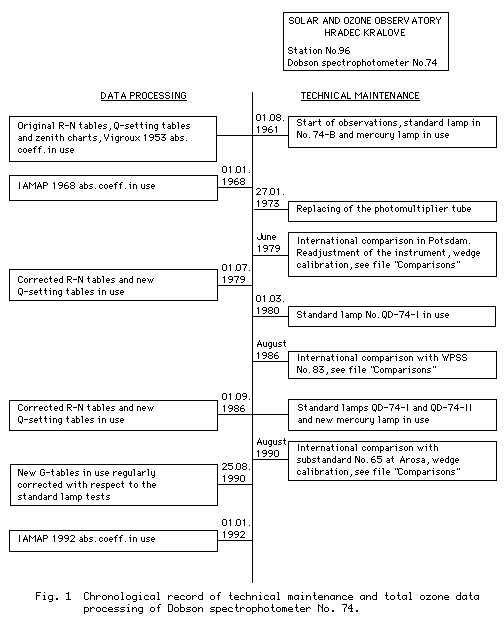
1.3 Comparisons with other Instruments
This type of observation is usually carried out in order to check the function of the spectrophotometer or to make a re-adjustment of its calibration level. The comparisons can be performed either by the institution or country concerned, or within the framework of international activities. In any case, the following information and data must be collected and filed for each comparison;
- date and place of station
- nature of comparison (national, international)
- identification of all participating instruments (number, station, owner)
- description and schedule of measurements (type of measurements, wavelength pairs, operators)
- sets of original readings (date, time, R-values, weather conditions)
- results and conclusions (differences in total ozone for individual wavelength pairs, corrections of R-N Tables, readjustment of Q-setting Tables, assessment of MU-dependency, etc.).
All materials for each comparison should be collected and archived in separate files including the final reports which were published later [e.g., Komhyr et al., 1986]. Special attention has to be paid to the files from comparison with World Primary Standard Dobson Spectrophotometer (WPSDS) No. 83 [Komhyr et al., 1989]. Information about Dobson instrument No. 83 calibration scales is provided in Section 2 of this Handbook. As all participants at the comparison usually get either originals or copies of all data sets and of final results, their files should also be available for inspection.
If the materials mentioned above are missing at the station and can not be collected by investigators, then the Climate Monitoring and Diagnostics Laboratory of the National Oceanographic and Atmospheric Administration (NOAA-CMDL), Boulder, Colorado can be asked for assistance. All information and data files from international comparisons with WPSDS No. 83 or US-secondary standard No. 65 are archived in this institution and are available for users of the instruments. These records describe relations of each spectrophotometer to the internationally implemented standards and they should be taken as primary sources for re-evaluation of instrument's constants related to the international calibration scale (see Section 2). As comparisons of the spectrophotometer are mostly associated with readjustment of its function or with repairs, they have to be registered in the record describing technical maintenance of the instrument. Therefore, the comparisons are also recommended to be marked in chronological order in the form of graph mentioned in paragraph 1.2.
1.4 Lamp Tests
Long-term behaviour and stability of the spectrophotometer are checked by means of the lamp tests in the period between two successive comparisons with standard instruments as described by Komhyr [Komhyr,1980]. The following tests are most important both for routine operation of the instrument and for reconstruction of its technical history. The first is the mercury lamp test that checks the condition of the optical alignment of the spectrophotometer. The others are the standard lamp tests which check for spectral characteristics changes of the Dobson instrument. The results of regular standard lamp tests for individual wavelength pairs create the fundamental data sets that are essential for correction and backward reconstruction of the R-N Tables (see Section 2). Therefore, the following information and data must be registered carefully.
Mercury Lamp Tests;
- Number of lamp(s), date and time of tests, raw data readings and differences from the
Q-setting table valid at the same period of time.
Standard Lamp Tests
- Type and number(s) of the lamp(s), period(s) of use, date and time of individual tests,
raw data readings of R-values and converted N-values for individual pairs.
When making the tests, the standard forms implemented by NOAA-CMDL are recommended to be used for saving the data given above (see Fig. 2). In order to observe the changes in condition of the Dobson instrument, either printed or graphical outputs of the results of tests are very helpful both for routine operation and for historical re-evaluation (see Fig. 3). The results of special measurements (tests with the NOAA-CMDL Travelling Standard Lamp Calibration Unit or with calibrated lamps of other spectrophotometers) should be separately filed. Since all changes of standard lamp readings are significant for keeping the spectrophotometer's calibration level constant, they must also be correctly recorded in the file of general maintenance of the instrument (see Fig. 1).
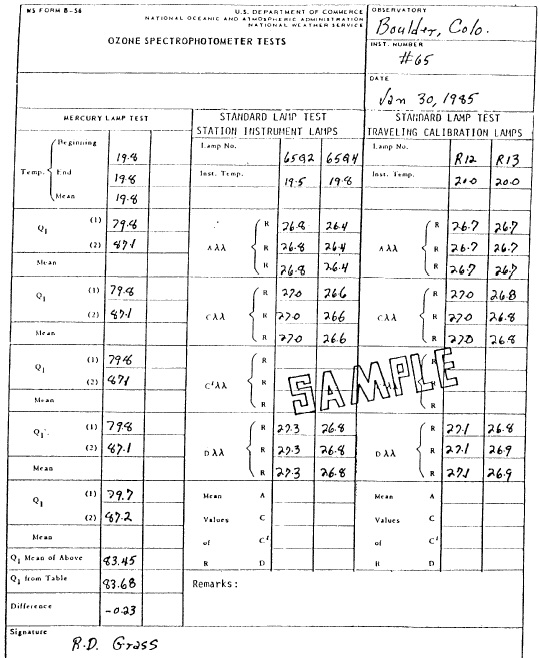
Fig. 2 Sample form for recording spectrophotometer lamp tests data.
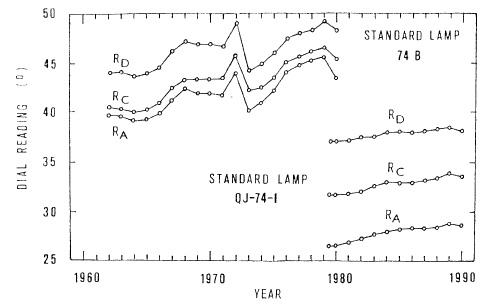
Fig. 3 Graphs of yearly averages of dial readings of standard
lamp tests, Dobson spectrophotometer No. 74.
1.5 R-N Tables
These tables convert R-readings to N-values. They represent relation between the technical condition of the instrument and the calculation of the total ozone values and are usually established at international comparisons. They are used in routine calculation of total ozone either as constant tables or they are regularly corrected using the results of standard lamp tests (see also Section 2 of this Handbook).
Before re-calculation of the total ozone data series, the use of all R-N Tables in the period under consideration must be checked for all wavelength pairs and chronologically ordered in a separate file. All changes of tables should be documented giving their time and the reason for change. The period of validity of each table must be carefully given. If the tables were regularly corrected between comparisons, this must also be noted.
If the total ozone data are to be re-processed, the R-N Tables of the instrument have to be reconstructed for the entire period of re-evaluation. First of all it is necessary to complete the historical file of standard lamp tests readings (see paragraph 1.4). In the second step, the R-N Tables established at the comparison(s) with standard instrument(s) must be taken as the reference one(s). Finally the backward corrections of these reference tables are calculated for the periods of stability of instrument's technical condition. The standard lamp readings from individual months and the correction method described by Komhyr [Komhyr, 1980] are recommended to be used for this purpose. Fig. 4 shows the results of such historical reconstruction of R-N Tables of the spectrophotometer No. 74 for the period 1962-1990. The reference R-N Tables established at Arosa in 1986 and tests with the standard lamps 74-B and QJ-74-1 were used for these backward corrections [Vanicek, 1991].
YEAR |
Standard Lamp Readings (°) Corr. of R-N Tables -------------------------- ------------------- RA RC RD RD-RA corNA corNC corND |
|
1962 1963 1964 1965 1966 1967 1968 1969 1970 1971 1972 1973 x 1974 1975 1976 1977 1978 1979 xx 1979 + 1979 ++ 1980 1981 1982 1983 1984 1985 1986 o 1987 1988 1989 1990 |
74-B Standard Lamp 39.75 40.26 43.87 4.12 5.64 7.06 5.71 39.70 40.23 44.06 4.36 5.69 7.09 5.52 39.09 39.78 43.48 4.39 6.30 7.54 6.10 39.19 40.16 43.92 4.73 6.20 7.16 5.66 39.80 40.93 44.62 4.82 5.59 6.39 4.96 41.23 42.54 46.18 4.95 4.16 4.78 3.40 42.50 43.23 47.20 4.70 2.89 4.09 2.38 41.87 43.44 46.85 4.98 3.52 3.88 2.73 41.95 43.35 46.80 4.05 3.44 3.97 2.78 41.80 43.30 46.60 4.80 3.59 4.02 2.98 44.10 45.90 49.00 4.90 1.29 1.42 0.58 39.90 41.80 43.84 3.94 5.49 5.52 5.74 40.82 42.35 44.95 4.13 4.57 4.97 4.63 42.25 43.50 46.15 3.90 3.14 3.82 3.43 44.13 45.13 47.60 3.47 1.26 2.19 1.98 44.75 45.70 48.00 3.25 0.64 1.62 1.58 45.30 46.20 48.35 3.05 0.09 1.12 1.23 45.68 46.62 48.63 2.95 -0.29 0.70 0.95 43.76 45.97 48.76 QJ-74-1 Standard Lamp 26.66 31.76 37.13 10.47 1.63 1.35 0.82 26.66 31.76 37.13 10.47 1.63 1.35 0.82 26.99 32.01 37.25 10.26 1.30 1.10 0.70 27.32 32.26 37.37 10.05 0.97 0.85 0.58 27.64 32.50 37.50 9.86 0.65 0.61 0.45 28.16 33.06 38.01 9.85 0.13 0.08 -0.06 28.33 33.13 38.08 9.75 -0.04 -0.20 -0.13 ----------------------------------------------- 28.29 33.11 37.95 9.66 0.00 0.00 0.00 ----------------------------------------------- 28.36 33.33 38.03 9.67 -0.07 -0.22 -0.08 28.59 33.48 38.08 9.49 -0.30 -0.37 -0.13 29.14 34.00 38.53 9.39 -0.85 -0.89 -0.58 28.70 33.65 38.16 9.46 -0.41 -0.54 -0.21 |
|
x Replacing of photomultiplier tube.
xx Values before readjustment of the instrument, valid till 7/79.
+ Values after readjustment of the instrument (Potsdam, 7/79).
+ Extended 1980 values, valid since 7/79.
o Reference values for corrections of R-N Tables.
Fig. 4 Yearly averages of standard lamp readings and corrections of R-N
Tables relative to 1986 reference values. Dobson spectrophotometer
No. 74, Hradec Kralove,1962-1990. |
||
1.6 Q-setting Tables and Wedge Calibrations
Shifts in the mechanical state of the spectrophotometer either for natural reasons or due to particular events can be identified by means of changes in the Q-setting tables or in the curves of two successive calibrations of the optical wedges. Therefore the establishment of files with these tables and graphs is very helpful for backward data re-evaluation as well. If wedge calibrations were made, the calibration unit(s), the date, the raw data readings, and the name of the operator should be registered. Any exchange of the wedges or replacing cement by an air space in the wedges should be recorded in the same way. As the changes of Q-setting tables and wedge calibrations are mostly done at comparisons of the instrument, the copies of materials mentioned above are also recommended to be saved in the files of comparisons (see paragraph 1.3). Utilization of the historical records of wedge calibrations is closely associated with specification of method for data re-processing which are described in Section 2.
1.7 Zenith Sky Charts/Polynomials
The zenith measurements represent a significant part of total ozone data sets at many stations. They can be processed both using zenith charts or polynomials. Changes of the charts or polynomials can influence homogeneity of the entire data series. Therefore, all updatings and corrections which were made in the past should be recorded and documented, so that technology of re-evaluation of zenith measurements described in Section 2 can be used.
1.8 Raw Data Sets
The raw readings which were made with the spectrophotometer during its operation represent the input data set(s) that will be reprocessed by some of the methods described in the next section. Before recalculation of total ozone these raw readings should be collected into the file in uniform protocols. For each individual series of measurements carried out at the station with given longitude, latitude and altitude, at least the following readings must be known;
- date and time of each reading (Local Time or True Solar Time must be specified)
- type of observation (Direct Sun, Zenith Blue, etc)
- R-readings for individual wavelength pairs weather conditions during observation (amount of clouds, visibility, turbidity); this is very important information for zenith measurements in particular.
The originally implemented forms similar to that shown in Fig. 5 or some updated version like that given in Fig. 6 are recommended to be used for this purpose.
Fig. 5 Original form for Dobson spectrophotometer total ozone
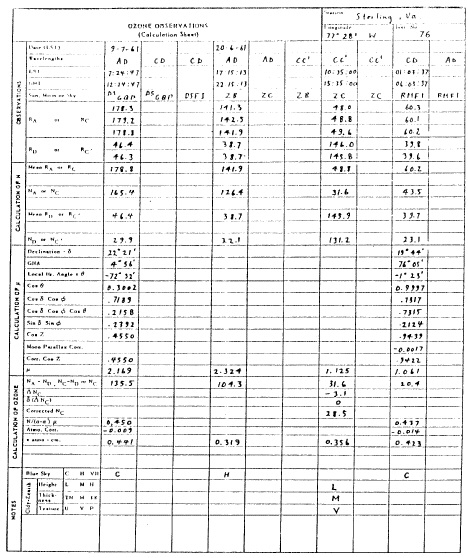
measurements and calculations.
PROTOCOL OF MEASUREMENTS OBSERVATORY : Hradec Kralove CORR. R-N TABLES: INSTRUMENT : Dobson No.74 corrNA = -0.4 UNITS OF OZONE : atm-cm (DU.10-3) corrNC = -0.5 REF. R-N TABLES : AROSA 1986 corrND = -0.2 |
DATE 01.06 01.06 01.06 02.06 02.06 02.06
1990 1990 1990 1990 1990 1990
-------------------------------------------------------------
TIME (LST) 09.30 10.33 13.02 10.37 10.40 11.51
MU 1.295 1.180 1.168 1.175 1.171 1.132
M 1.297 1.181 1.169 1.176 1.172 1.132
SUN/SKY ZC ZC ZB DS ZB DS
RA 139.3 129.8 125.2 131.8 115.7 125.4
RC 71.4 67.6 64.7 78.7 58.0 75.0
RCC 184.5 179.3
RD 41.3 40.0 38.1 55.4 33.7 53.0
NA 100.0 92.1 88.4 93.8 80.6 88.5
NC 47.3 44.4 42.3 52.9 37.3 50.0
NCC 136.8 132.3
ND 21.6 20.6 19.1 32.4 15.6 30.6
TOTAL OZONE
XC 0.429 0.420
XCC 0.412 0.415
XAD 0.410 0.406 0.396 0.368 0.369 0.360
XCD 0.389 0.392 0.385 0.382 0.362 0.376
-------------------------------------------------------------
WEATHER Z=Sc2 Z=Sc2 Z=blue S=clr Z=blue S=clr
10/10Sc2 10/10Sc2 3/10CiO clear clear 2/10Cul
6 km 6 km 6 km 8 km 6 km 5 km
|
Fig. 6 Modified form for Dobson spectrophotometer total ozone
measurements and calculations printed by means of the computer.
|
After creation of this file, its examination is necessary so that all interruptions of measurements, missing raw data, or periods with some recording errors can be found and investigated. Maximum attention should be paid to searching all original records of measurements in order to create the final raw data set as complete as possible. The results of investigation of an instrument's history described in the paragraph 1.1 can be very helpful for this work. To make the inventory easy to survey and simple for use, the time lines of total ozone measurements carried out on individual wavelength pairs (see Fig. 7) and their frequency are recommended to be drawn up as well.
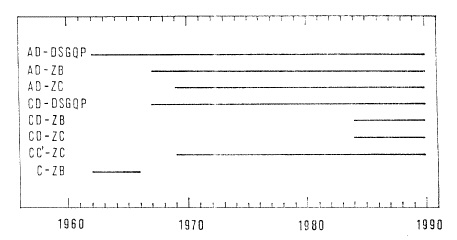
Fig. 7 Time lines of total ozone measurements, performed on different wavelength
pairs with spectrophotometer No. 74, Hradec Kralove, 1962-1990.
If original raw data readings are not available, but the ozone data exist, they also should be collected and filed. Correction of these historical data is possible using corrections of extraterrestrial constant(s) of the instrument(s).
Re-processing of the long-term data series of total ozone represents a large amount of work that should be done by means of the computer. Therefore, it is desirable to put the raw data and the other historical records described in paragraphs 1.1-1.6 on magnetic discs before re-evaluation of the entire data series. This will also be useful should a world Dobson instrument raw-data base be built in the future.
1.9 Conclusions
Examination of instrument histories is the first step that is necessary to be carried out at the very beginning of the Dobson data re-evaluation. Collection of all available records which describe a spectrophotometer's technical condition, its operation and entirely raw data sets are the chief goals of these activities. The files created in this way help to make decisions on the methodology of data re-processing and characterize quality of the input data sets. The recommendations and instructions given in this section represent an ideal condition concerning availability of historical records of each instrument. In reality some of these records will be missing at individual stations. Therefore, the specialists involved in re-evaluation have to be creative in application of the methods described here, and they should adjust them to their specific situation.
References
1. Komhyr, W.D., Operations Handbook - Ozone Observations with a Dobson
Spectrophotometer,
Global Ozone Research
Project, WMO Report
No. 6, 1980.
2. Komhyr, W.D., R.D. Grass, R.D. Evans, and R.K. Leonard,
1988: Results of International Dobson
Spectrophotometer and Brewer Spectrometer Intercomparisons. Arosa, Switzerland, 1986.
Proceedings of Quadrennial Ozone
Symposium, Gottingen, Germany.
3. Komhyr, W.D., R.D. Grass, and R.K. Leonard, 1989: Dobson Spectrophotometer No. 83:
A Standard for Total Ozone Measurements
1962-1987, J. Geophys. Res., 94
(D7), 9847-9861.
4. Vanicek, K., 1991: Recalculated Total Ozone Data, Hradec Kralove 1962-1990.
Publs. of the
Czech Hydrometeorological
Institute Praha.